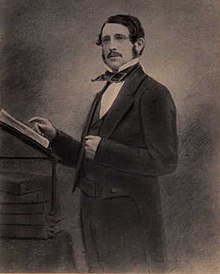Thomas Smith (18 October 1823 – 13 March 1869) was a British baker and confectioner who is traditionally described as the inventor of the Christmas cracker, in 1847.[1][2][3]

Early life
editThomas Smith was born in Newington, then in Surrey, in 1823, the son of Priscilla (née Flight; 1787–1873) and Thomas Bruce Smith (1798–1860), a grocer.[4][5] In 1830, the 7 year-old Tom Smith began work in a baker and ornamental confectioners shop in London. Over the years as an apprentice he learned his trade until he became a master in his craft, experimenting with new designs and ideas in his spare time. Smith opened his first shop in Goswell Road in Clerkenwell in London's East End in the 1840s where he baked wedding cakes and confectionery on the premises. When Smith went to Paris in 1846, he came across the French 'bonbon', a sugared almond wrapped in a twist of tissue paper. Taking the idea back to London Smith's take on the bonbon proved to be very popular, particularly at Christmas time.[6]
The Christmas Cracker
editAs interest in his bonbons began to wane Smith had to come up with new ideas to promote sales. His first idea was to include love messages in the wrappers of the sweets in a similar way to that found in fortune cookies.[7] In 1849 Smith replaced the bonbon[8] with such items as fans, jewellery and trinkets.[9] In 1860 Smith added the 'snap' element, the myth being that he added this when he heard the crackle of a log on a fire.[3][7][10][11] In reality 'Waterloo Crackers' as they were sometimes called had been around for decades by 1860 after the discovery of silver fulminate by the chemist Edward Charles Howard in 1800 and its further development by Luigi Valentino Brugnatelli in 1802 of a safe way of using it in amusements and for practical jokes. Smith bought the design and formula for the "snap" in his crackers from a chemist called Tom Brown who had worked for the Brocks Fireworks company.[12]
The size of the hand-made paper wrapper had to be increased to take the banger strip, and at first Smith named his creation the Bangs of Expectation and later as the Cosaque (French for Cossack);[9] but the onomatopoeic "cracker" quickly became a more popular name and served to distinguish Smith's product from that of his competitors. In the 1861 Census Tom Smith is listed as living at Brontë Cottage in Hampstead and described himself as a "manufacturing confectioner employing 7 men and 16 women".[13]
Walter Smith, one of the three sons of Tom Smith who took over the running of the company after his death, originated the idea of the cracker as we know it today; it was he who decided to include the gifts and paper hats that then differentiated the Tom Smith cracker from that of their competitors.[10] Walter Smith sourced the gifts for inside the crackers from across Europe, America and Japan.[8] By the 1890s sales of crackers were so successful that the company was employing 2,000 staff, many of whom were women, and was able to relocate to larger premises in Finsbury Square.[6] In 1953 Tom Smith & Company merged with Caley Crackers.
Family
editSmith married Martha née Hunt (1826–1898) in London in 1848[14] and with her had seven children: Thomas Smith (1849–1928); Henry John Smith (1850–1889); John Smith (1852–1853); Walter Smith (1854–1923); twins Emanuel Smith (1857–1857) and Martha Smith (1857–1939); Priscella Smith (1858–1929), and Francis (Frank) Smith (1860–1878). His three sons Walter, Henry and Thomas Jnr. succeeded him in running the business.
Tom Smith died at his home at 320 City Road aged 46 in 1869[15] from stomach cancer and is buried in Highgate Cemetery in London.[16]
Legacy
editA memorial water fountain to Tom Smith and his family stands in Finsbury Square, London.[17][18]
References
edit- ^ Peter Kimpton (2005) Tom Smith's Christmas crackers: an illustrated history, Tempus ISBN 0-7524-3164-1
- ^ Margaret Baker (1992) Discovering Christmas customs and folklore: a guide to seasonal rites, p.72, Osprey Publishing ISBN 0-7478-0175-4
- ^ a b The history of Christmas crackers – History Extra: the official website for BBC History Magazine, BBC History Revealed and BBC World Histories Magazine
- ^ 1851 England Census for Thos Smith – Middlesex, Islington, Islington East – Ancestry.com (subscription required)
- ^ London, England, Church of England Births and Baptisms, 1813–1917 for Thomas Smith – Southwark, St Mary, Newington, 1816–1828 – Ancestry.com (subscription required)
- ^ a b The History of the Christmas Cracker – Victoria & Albert Museum Collection
- ^ a b Fletcher, Damien (22 December 2011). "Christmas traditions: The history behind crackers, mistletoe, turkey, stockings, tinsel, mince pies and more". Daily Mirror. Retrieved 25 December 2012.
- ^ a b History of the Christmas cracker – Tom Smith & Company website
- ^ a b Callow, Simon (2009). Dickens' Christmas. London: Frances Lincoln. p. 138. ISBN 978-0711230316.[permanent dead link]
- ^ a b "History of the Christmas Cracker". History. Tom Smith Crackers. Archived from the original on 27 August 2013. Retrieved 25 December 2012.
- ^ The Ten Ages of Christmas: Christmas cards and crackers – BBC History website
- ^ Christmas Cracker Invention: Tom Smith's Magical Invention
- ^ 1861 England Census for Thomas Smith – Middlesex, Hampstead – Ancestry.com (subscription required)
- ^ London, England, Church of England Marriages and Banns, 1754–1932 for Thomas Smith – Islington, St James, Clerkenwell, 1845–1854 – Ancestry.com (subscription required)
- ^ England & Wales, National Probate Calendar (Index of Wills and Administrations), 1858–1995 for Thomas Smith 1869– Ancestry.com (subscription required)
- ^ Goodman, Sheldon K. (21 December 2018). "Where is the Inventor of the Christmas Cracker?". Cemetery Club. Retrieved 24 December 2023.
- ^ "London Christmas Past: The Invention Of The Christmas Cracker" (5 Dec. 2012) Londonist
- ^ "How Finsbury Square Gave The World A Christmas Tradition" (5 Dec. 2014) Londonist